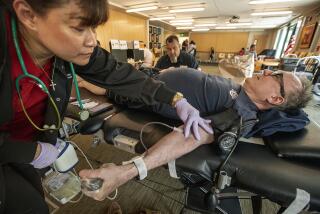‘Bloodless’ Surgery Becoming a Popular Option for Patients
- Share via
Janet Davis asked all the usual questions about how long her surgery would take and when she could get back to work.
But the 37-year-old Hacienda Heights office manager, scheduled to undergo a modified mastectomy, had yet another concern. She definitely did not want a blood transfusion. Although a transfusion is not commonly needed after a modified mastectomy, Davis, a Jehovah’s Witness, needed to be sure her surgeon understood her wishes. Her religion prohibits transfusions.
As it turned out, she was having surgery at the right place. Her doctor operates at Brotman Medical Center in Culver City, one of a growing number of hospitals offering “transfusion-free” or “bloodless” surgery programs.
The approach, developed about 40 years ago, depends on careful preparation of the patient and attention to surgical techniques to minimize blood loss.
*
The Stats: Nationwide, there are now more than 50 formal programs, including a handful in Southern California, estimates Wayne M. Henderson Jr., Brotman’s Bloodless Medicine and Surgery Program coordinator, who predicts more growth as demand rises.
At hospitals without formal programs, it is also possible to perform bloodless surgeries if the surgery team understands the philosophy, other experts say.
While most patients requesting the approach are Jehovah’s Witnesses (who believe acceptance of blood transfusions is prohibited by Scripture), growing numbers of other patients are asking about the option too, citing concerns about the safety of the blood supply or adverse reactions to a transfusion.
“They just want to be sure that blood will be used only as a last resort,” says Dr. Rafael Reisfeld, a Culver City surgeon who is medical director of the Brotman Medical Center Bloodless Medicine and Surgery Program.
*
The Programs: Before surgery, a patient is given injections of erythropoetin, if needed. “It’s a bone marrow stimulant that causes the bone marrow to crank out more red blood cells,” says Dr. Gregory Kay, a cardiac surgeon and director of the cardiac surgery unit at Good Samaritan Hospital, which also operates a bloodless surgery program.
The goal is to boost red blood cell concentration so some blood can be lost with fewer ill effects. About 20% of patients need the erythropoetin buildup, generally given for a few weeks before surgery. During this buildup phase, patients are also given iron and vitamins. It’s also important to be sure the patient is not on blood thinners.
If surgery is done on an emergency basis, the erythropoetin can be given postoperatively, Reisfeld adds.
*
The Surgeon’s Role: In the operating room, the surgeon focuses on minimizing blood loss throughout the surgery. The anesthesiologist and other team members should be experienced in transfusion-free surgeries.
And the surgeon must pay close attention to technique. “When you put in the monitoring lines, you have to be careful you don’t lose a lot of blood,” Kay says. “Instead of making a cut [during the surgery] and letting things bleed, you make a lesser incision and control the bleeding.”
An instrument called a cell saver, which separates blood from its components and returns it to the veins, is sometimes used.
*
The Risks: Just 25 years ago, blood transfusions were very dangerous. “They didn’t have the technology to test the blood,” Kay says.
These days, transfusions are safer but not risk-free. The problem, says Reisfeld, is emerging and unidentified viruses.
The risk of contracting HIV from a unit of blood is about 1 in 500,000, says Dr. Ross Herron, medical director of the American Red Cross, Los Angeles, citing statistics from the federal Centers for Disease Control and Prevention; the risk of contracting hepatitis B is 1 in 200,000.
About 10% of transfused patients have minor side effects such as fever, Kay says, but serious reactions are rare. Even so, “I would only take a blood transfusion to save my life.”
But the bloodless approach can involve compromise too, says Dr. Dennis Goldfinger, director of the division of transfusion medicine at Cedars-Sinai Medical Center. “It’s important that people not be misled into thinking that surgery without blood transfusion can always be performed as safely.” Liver transplant patients, for instance, are likely to require transfusions, he says.
*
Predictions: Forecasting who will need a transfusion is impossible, although there are some generalizations. The smaller or older you are, the more likely it is that you will need a transfusion.






